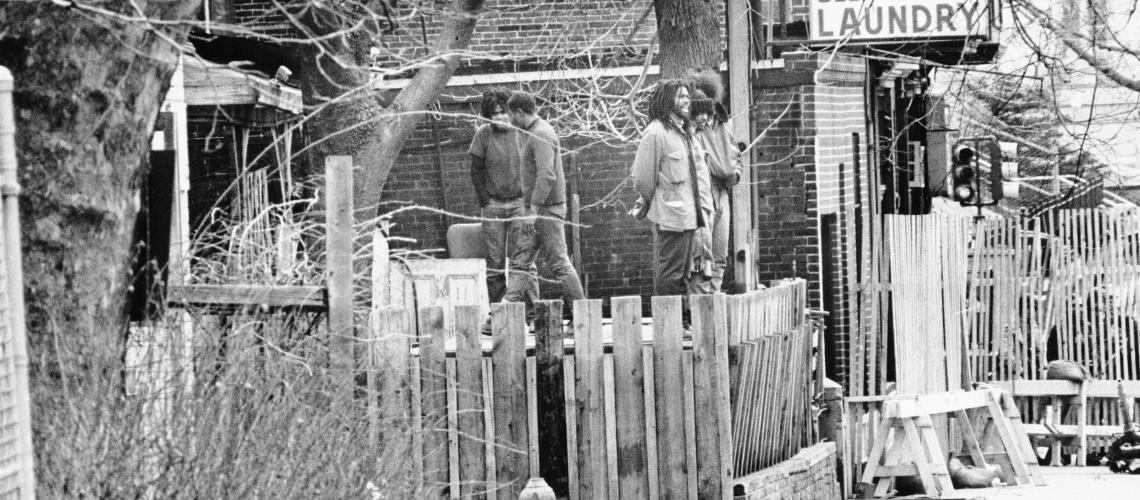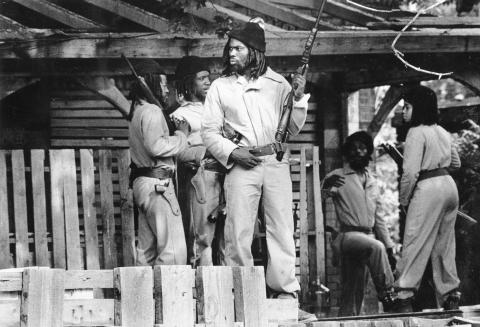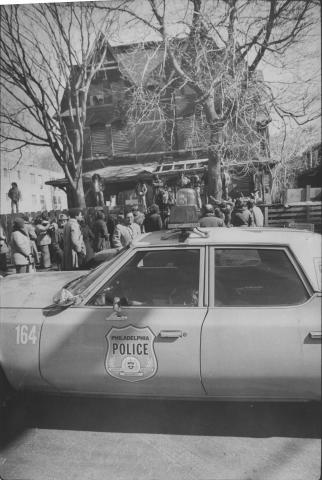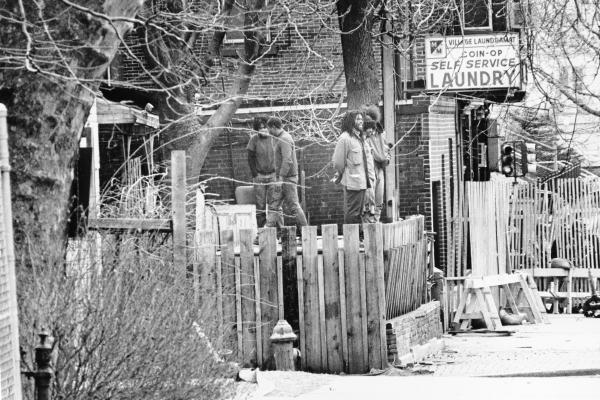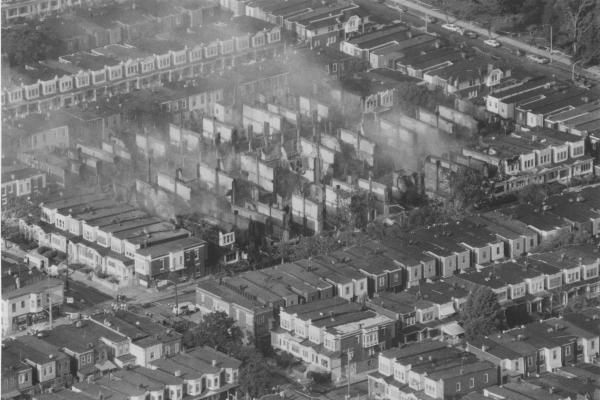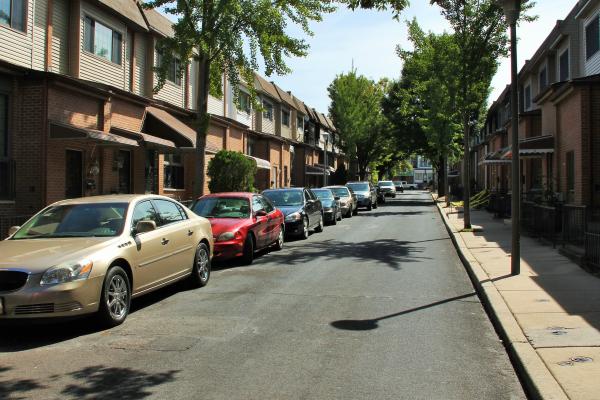MOVE in Powelton Village
Part of
From 1973 to 1978, members of MOVE adopted a radically alternative, anti-technology lifestyle and displayed a political militancy that provoked a devastating assault by the Philadelphia police on the organization’s Powelton Village headquarters.
In 1973, a group of West Philadelphians—guided by the anti-establishment principles of charismatic Mantua resident, Vincent Leaphart (later self-renamed John Africa)—came together as MOVE. MOVE (not an acronym) adopted a radically alternative lifestyle and militant political practices that created antagonistic relationships with both their neighbors and the Philadelphia Police Department. In August 1978, after almost a year of failed negotiations to resolve an earlier conflict, Mayor Frank Rizzo ordered an attack on MOVE’s Powelton Village headquarters that resulted in the destruction of the headquarters, the death of a police officer, and the virtual life sentences of nine MOVE members.
Vincent Leaphart, a native of West Philadelphia’s Mantua neighborhood, founded MOVE in the early 1970s. Born into a large family during the depression, Leaphart attained only a third-grade level education. After serving in the Korean War, Leaphart attempted an interior design career in New York City, but returned to Powelton Village in West Philadelphia where he worked occasionally as a handyman. In the 1960s, Leaphart adopted a “philosophy of life” that centered around the belief that “the system”—man-made constructions of law, government, and industry—was the source of all problems.[1]
By the early 1970s, social worker Donald Glassey met Leaphart, who was now going by the name John Africa. Glassey, excited by Africa’s ideas, offered to transcribe them and the resulting book was The Guidelines. The charismatic John Africa soon recruited more followers. Though the followers were not of one particular age and race, all shared a history of hardship for which Africa and The Guidelines appeared to provide a solution.
Africa and his disciples formed MOVE. The word itself was not an acronym—quite simply, MOVE was MOVE. The group identified as a religious and political organization. All MOVE members adopted the surname Africa, took on the age of 1 (to symbolize a rebirth), and wore their hair in dreadlocks.
In 1974, MOVE acquired a decaying 3½-story Victorian twin house at 309 North 33rd Street and at a later point the adjoining twin at 307 North 33rd Street. The large, now single, house served as the operational headquarters and living space for MOVE members and their children. To earn money, MOVE operated a neighborhood carwash at 307–309 North 33rd, and its members shoveled sidewalks and performed repairs for elderly people in the neighborhood.
Residents practiced a lifestyle in accordance with The Guidelines. The house was heated by burning wood and children were homeschooled to avoid learning to read and write (deemed “synthetic education”).[2]
From this base in Powelton Village, MOVE’s lieutenants fanned out across the city to stage non-violent but disruptive protests that featured what they called “strategized profanity.” The protests occurred at various arenas where they felt natural law to be in jeopardy: at pet stores, the Philadelphia Zoo, political rallies, and speaker forums. With numerous unlawful demonstrations, MOVE members positioned themselves to be in perpetual conflict with city police and the political establishment. According to police reports, MOVE mounted 38 demonstrations in 1975, and its members were arrested 142 times pursuant to 61 court appearances.
MOVE maintained a complicated relationship with their neighbors. Powelton Village was a liberal-minded neighborhood famous for its countercultural values, live-and-let-live tolerance, and rich diversity of people and lifestyles. Many residents were activists and protestors, and regarded Mayor Frank Rizzo as racist. In The Phoenix, Powelton Village’s newsletter, Randy Dalton—searching for commonalities during a 1977 MOVE conflict—described positive qualities MOVE shared with the community despite the problems they posed for their neighbors:
We both are trying to find a better way to live; we both feel the system isn't responsive to our needs; we both feel people, who are oppressed and poverty-stricken, may not deserve to be so […][3]
Yet MOVE also tested the tolerance of Powelton residents. MOVE’s central mission to revolt against societal structures naturally conflicted with the informal construction of common neighborly decorum. MOVE disposed of garbage in their backyard as a form of compost. The refuse had a strong odor which attracted cockroaches and rats. Animal rights are equal to human rights as a part of MOVE philosophy, and so the vermin were not removed.[4] Additionally, MOVE took in a large number of stray or injured dogs, and over time, accumulated a large pack that wandered freely, as per their beliefs on animal confinement.[5] Residents reported to city officials being threatened by MOVE. Some claimed that MOVE took action on those threats. Community members who publicly claimed they were threatened ran the risk of harassment or even a public evisceration in On The Move, Louise Africa’s column in the Philadelphia Tribune.[6]
Mayor Rizzo regarded MOVE as a terrorist organization and was determined to remove it from Powelton Village. Between 1973 and 1976, city officials, taking their cue from the Rizzo, were increasingly alarmed by MOVE’s activities, which they suspected included hoarding firearms.
The situation boiled toward a violent confrontation in 1977. On May 20, city health inspectors trying to enter the house were met on the porch by MOVE members dressed in jumpsuits and green berets, and brandishing rifles. The “guns on the porch” display was non-violent bravado, and Rizzo’s police did not press the issue.
For nearly a year after the initial standoff, MOVE members barricaded themselves inside the house while the police maintained around-the-clock surveillance. After a 10-month stalemate, on March 1, 1978, Rizzo obtained an order from the Philadelphia Court of Common Pleas to blockade the house, deny MOVE access to city water, and prevent anyone from resupplying house. The blockade also impacted Powelton Village residents. Those residing within the blockade had to be escorted to and from their houses, but the effect was more psychological than physical discomfort. Tensions caused by the initial disputes with MOVE were heightened following the city's intervention. Two community groups formed to manage the range of responses from the neighborhood. One of those group assisted the city in its negotiations with MOVE.[7] The Phoenix interviewed nine random residents within the blockaded zone, and elicited a range of opinion:
Several feared outside agitators would trigger violence while others were more afraid of either the police or MOVE. One believed the blockade violated civil rights because it made siege a precedent for eviction, while another blamed protestors against it for using civil rights as a political football. Some believed the blockade to be a racist strategy, while others were as sure it wasn't. Some blamed Rizzo for it, but others were outraged at MOVE. All doubted the blockades would resolve anything. All felt mishandled by the siege. All were agitated by the divisions it had underscored and created.[8]
On May 3, Rizzo acquiesced in a court-approved compromise: MOVE would surrender its weapons, allow an inspection of the house, and, finally, leave the house by August 1; in exchange, the city agreed not to arrest members who had no outstanding warrants and to expedite the trials of jailed members.
MOVE violated its agreement with the Court of Common Pleas by not vacating the house by August 1. A Court of Common Pleas judge issued arrest warrants for the adult occupants.
At dawn on August 8, the authorities towed parked vehicles off the block; then the police ordered, through a bullhorn, the MOVE occupants to vacate the house immediately. When MOVE refused to comply, a police-driven bulldozer pulverized the wooden barricade members had erected in the front of the house; a cherry picker followed in the path of the bulldozer and knocked out the wooden slats MOVE had mounted on windows. High-pressure hoses blasted thousands of gallons of water into the house. A gun battle ensued. A veteran police officer, James Ramp, was killed in the melee; two other officers and three firefighters were wounded.
Tear gas finally forced MOVE to surrender. The police arrested 12 adults and removed 11 children, ages 18 months to 12 years, from the battered house, which, by evening, was a pile of rubble. No child was injured. Enraged by Ramp’s shooting, police bludgeoned MOVE member Delbert Africa—an incident that was filmed by a Philadelphia Inquirer reporter; the three officers charged in the beating were acquitted at trial.
In December 1979, 11 MOVE members, including Delbert Africa, stood trial for murder and the lesser crimes of aggravated assault and conspiracy. MOVE contended that Ramp’s fellow officers, not any occupant of 307–309 North 33rd Street, had shot Ramp, either accidentally or purposefully. MOVE was framed, its members argued, and the city’s razing of the house had destroyed any evidence that might incriminate the police or exculpate MOVE.
In May 1980, nine of the defendants (five men and four women) were convicted in the murder of James Ramp and sentenced to prison terms ranging from 30 to 100 years. For the next five years, MOVE would focus its disruptive protest actions on the liberation of the “MOVE 9.” [9]
